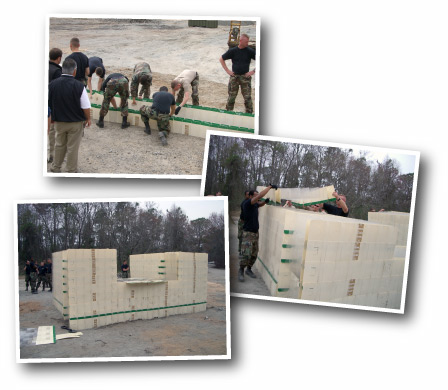| RAPID DEPLOYMENT FLOOD WALL |
| RDFW BROCHURES (PDF FORMAT) |
| RDFW VIDEOS |
| SECURITY & MILITARY APPLICATIONS |
| NEWS |
| ABOUT GEOCELL SYSTEMS |
| CONTACT US |
| GSA SCHEDULE |
| LINKS |
| PRESS KIT |
|
|

USAF Builds RDFW Walls in Iraq
Aug 3, 2005
After months of testing in military labs against blast and ballistic threats, RDFW was recently deployed by a US Air Force security forces squadron in Iraq. The squadron constructed a tall wall around a high-value facility on base.
|
The squadron’s first experience with RDFW came during a stateside training session prior to deployment. Geocell instructors visited the squadron at their home base in the southern United States for a two-day training session. Squadron personnel quickly learned how to use RDFW to build walls, bunkers, roads, and for rapid runway repair. “The security forces squadron that we worked with are a sharp bunch,” remarks Geocell President Al Arellanes. “They’d never heard of RDFW before our training session, but once we opened the crate and showed them the basics, they had their first wall built in under 20 minutes. Inside of an hour they were assembling RDFW with expert speed. And by the end of the day, they were putting up advanced structures like bunkers and doing runway repair. They are now prepared to train others.” But it's not just that these Air Force personnel are quick learners; RDFW is manufactured with a number of markings and design features which make it easy to work with and difficult to assemble improperly. On top of this, RDFW’s modular nature gives it the versatility to be used for construction of a wide range of structures beyond basic straight walls. The RDFW grids are made to stack and have locks for connecting to one another without the use of tools or additional pieces. “Think of RDFW as Legos for adults,” explains Arellanes. |
 Once in Iraq, the security forces squadron used its RDFW to construct tall walls surrounding high-value facilities on base. RDFW’s simplicity and ease-of-use made the job quick and relatively painless. Unlike traditional sandbag walls, RDFW naturally stacks into neat, vertical walls. And RDFW requires 99% less labor-hours than sandbag wall construction. Once in Iraq, the security forces squadron used its RDFW to construct tall walls surrounding high-value facilities on base. RDFW’s simplicity and ease-of-use made the job quick and relatively painless. Unlike traditional sandbag walls, RDFW naturally stacks into neat, vertical walls. And RDFW requires 99% less labor-hours than sandbag wall construction.
“I’ve filled my share of sandbags in my life,” says Arellanes. “The last thing you want to be doing in 135-degree desert heat is filling, carrying, and stacking 50 tons of sandbags.” In addition to building simple, vertical walls, RDFW also has the bearing strength to support massive loads. RDFW makes easy the construction of bunkers, command posts, checkpoints, and other fortifications requiring thick overhead protection against threats like mortars. All that's required is RDFW, some beams, and some plywood or sheeting. In addition to its use for fortifications, RDFW also has other combat versatility. Without any modifications, standard RDFW can be used to rapidly repair craters in runways, and to rapidly construct heavy-duty roads over soft terrain. “For craters, just square out your hole a little bit, put a couple of layers of RDFW inside, and then backfill with sand or gravel. Put a quick paving job or a plate on top of that and you’re operational again,” explains Arellanes. “A small construction crew can have a job like that done in just a few minutes.” “Roads are even easier,” says Arellanes. “Just lay down a layer or two of grid, fill with sand or earth, and you’re done. You’ve got an instant road over a mud bog or a sandy beach.” |

